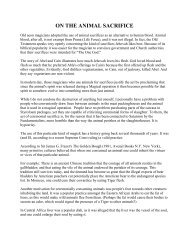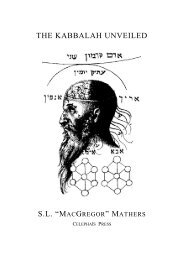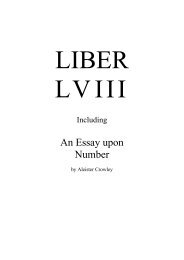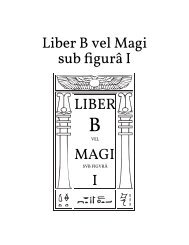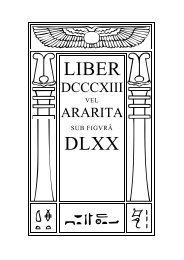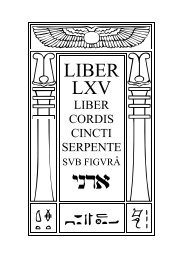Annotated Ritual of the Eucharist
Annotated Ritual of the Eucharist
Annotated Ritual of the Eucharist
Create successful ePaper yourself
Turn your PDF publications into a flip-book with our unique Google optimized e-Paper software.
(The exceptions to this part <strong>of</strong> <strong>the</strong> ceremony are when it is <strong>of</strong> <strong>the</strong> nature<br />
<strong>of</strong> a celebration, in which case none but <strong>the</strong> PRIEST communicate; or<br />
part <strong>of</strong> <strong>the</strong> ceremony <strong>of</strong> Marriage, when none o<strong>the</strong>r, save <strong>the</strong> two to<br />
be married, partake; part <strong>of</strong> <strong>the</strong> ceremony <strong>of</strong> Baptism, when only <strong>the</strong><br />
child baptised partakes; and <strong>of</strong> Confirmation at puberty, when only<br />
<strong>the</strong> persons confirmed partake. The Sacrament may be reserved by<br />
<strong>the</strong> PRIEST, for administration to <strong>the</strong> sick in <strong>the</strong>ir homes. 137 )<br />
The PRIEST closes all within <strong>the</strong> veil. With <strong>the</strong> Lance he makes on<br />
<strong>the</strong> people thrice, thus:<br />
The PRIEST: The LORD bless you.<br />
The LORD enlighten your minds and comfort your hearts and sustain your<br />
bodies.<br />
The LORD bring you to <strong>the</strong> accomplishment <strong>of</strong> your true Wills, <strong>the</strong> Great<br />
Work, <strong>the</strong> Summum Bonum, True Wisdom and Perfect Happiness.<br />
He goes out, <strong>the</strong> DEACON and children following, into <strong>the</strong> Tomb <strong>of</strong> <strong>the</strong><br />
West. 138<br />
Music. (Voluntary.) 139<br />
whereabouts during popular communion are a matter <strong>of</strong> divergent local traditions. Since <strong>the</strong> rubric prompts no<br />
movement on his part, <strong>the</strong> most conservative reading is for him to remain before <strong>the</strong> Priestess, where he may<br />
stand facing West if he does not obstruct her face. (Again, a full-height altar is important!) Alternatively, an<br />
assisting <strong>of</strong>ficer may put a chair in place on <strong>the</strong> dais, so that <strong>the</strong> Priest may sit below <strong>the</strong> Priestess in <strong>the</strong> East.<br />
This seemingly radical move is really no more creative than <strong>the</strong> widespread—and perfectly acceptable—custom<br />
<strong>of</strong> placing <strong>the</strong> Priest in <strong>the</strong> West during popular communion. Agapé Lodge tradition put <strong>the</strong> Priest to one side<br />
<strong>of</strong> <strong>the</strong> High Altar, but this option may obstruct <strong>the</strong> <strong>of</strong>ficers serving <strong>the</strong> elements, and it introduces a<br />
conspicuous imbalance to <strong>the</strong> shrine. When serving as Priest myself, I have <strong>of</strong>ten chosen to depart <strong>the</strong> shrine<br />
and to join with <strong>the</strong> musicians during popular communion.<br />
136 Helena & T Apiryon note: “According to Agapé Lodge tradition, <strong>the</strong> communicant faces <strong>the</strong> Priestess while<br />
speaking <strong>the</strong>se words.” And fur<strong>the</strong>r, after considering <strong>the</strong> custom <strong>of</strong> facing <strong>the</strong> congregation: “There is<br />
meaning to be found in both customs, and local bodies should be prepared to accommodate communicants<br />
who wish to take communion ei<strong>the</strong>r way. In turn, while attending Gnostic Mass in different areas,<br />
communicants should be sensitive to local custom.” There is no programmed response to individual<br />
communicants. Musicians should not pause for communicants to speak; spontaneous applause, laughter, etc. are<br />
blameless, but clergy should be on guard against local additions to <strong>the</strong> rubric regarding this critical moment <strong>of</strong><br />
participation.<br />
137 An approved ritual for this purpose is available. At <strong>the</strong> end <strong>of</strong> <strong>the</strong> people’s communion, <strong>the</strong> positive child<br />
returns <strong>the</strong> paten to <strong>the</strong> Priestess. The Priestess and Priest should carefully consider and manage <strong>the</strong> disposition<br />
<strong>of</strong> any consecrated cakes on <strong>the</strong> paten that are left unconsumed.<br />
138 The Deacon replaces <strong>the</strong> veil <strong>of</strong> <strong>the</strong> tomb. Although many have read this text to indicate that <strong>the</strong> deacon<br />
and children enter <strong>the</strong> tomb, such a procedure would be impossible with an “upright c<strong>of</strong>fin,” indicated as a<br />
possible tomb design by Crowley. Moreover, it is useful for <strong>the</strong> Deacon to remain visible and present to<br />
supervise <strong>the</strong> exit <strong>of</strong> <strong>the</strong> people from <strong>the</strong> temple.<br />
139 The doorkeeper from <strong>the</strong> rubric at <strong>the</strong> top <strong>of</strong> section III (who can be appointed ad hoc by <strong>the</strong> Deacon<br />
immediately before <strong>the</strong> Mass) should promptly open <strong>the</strong> door and lead <strong>the</strong> people out <strong>of</strong> <strong>the</strong> temple as <strong>the</strong><br />
music plays.<br />
Liber XV with Practical Annotations by T Polyphilus, Ep. Gn. 26



